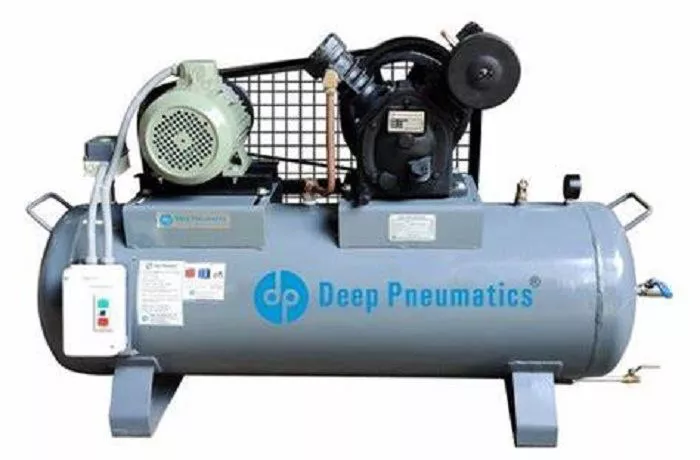A two-stage reciprocating air compressor is a highly efficient and robust machine designed to deliver high-pressure compressed air for industrial, commercial, and specialized applications. Unlike single-stage compressors, which compress air in a single piston stroke, two-stage compressors utilize two consecutive compression phases to achieve higher pressures with improved efficiency and reduced heat generation.
Working Principle of a Two-Stage Reciprocating Air Compressor
First Stage Compression
- Ambient air is drawn into the low-pressure (LP) cylinder through an intake filter.
- The piston compresses the air to an intermediate pressure (typically 30-100 psi, depending on design).
- The compressed air exits the first stage and passes through an intercooler.
Intercooling Stage
- The intercooler reduces the air temperature before it enters the second stage.
- Cooling improves efficiency by minimizing thermal losses and reducing the work required for further compression.
Second Stage Compression
- The pre-compressed air enters the high-pressure (HP) cylinder, where it undergoes further compression.
- The final discharge pressure typically ranges between 100-175 psi (or higher for specialized applications).
- The high-pressure air then moves to an aftercooler to reduce temperature before storage or use.
Thermodynamic Advantages
Reduced Work Input: Staged compression with intercooling approximates isothermal compression, which is more efficient than adiabatic (single-stage) compression.
Lower Operating Temperatures: Heat dissipation between stages prevents overheating and reduces wear on components.
Higher Pressure Ratios: Two-stage compressors can achieve pressure ratios (final pressure/intake pressure) that would be impractical in a single stage.
Key Components of a Two-Stage Reciprocating Air Compressor
Cylinders & Pistons
Low-Pressure (LP) Cylinder: Larger in diameter, handles initial compression.
High-Pressure (HP) Cylinder: Smaller in diameter, further compresses the air.
Pistons: Connected to a crankshaft via connecting rods, converting rotary motion into linear reciprocation.
Intercooler & Aftercooler
Intercooler: Cools air between stages to improve efficiency.
Aftercooler: Reduces discharge air temperature, minimizing moisture content.
Valves
Intake & Discharge Valves: Check valves ensure one-way airflow.
Unloader Valves: Reduce startup load by releasing trapped air.
Lubrication System
Splash Lubrication (for smaller units): Oil splashes onto moving parts.
Pressure Lubrication (for industrial units): Oil pump delivers lubricant to bearings and cylinders.
Advantages of Two-Stage Reciprocating Compressors
Higher Efficiency
Staged compression reduces energy consumption by up to 15-20% for the same output pressure.
Greater Pressure Capability
Capable of delivering 175+ psi, making them ideal for heavy-duty applications.
Improved Durability
Lower operating temperatures extend component lifespan.
Applications of Two-Stage Reciprocating Air Compressors
Industrial Manufacturing
Pneumatic tools, CNC machines, assembly lines.
Automotive & Aerospace
Tire inflation, paint spraying, component testing.
Oil & Gas
Pneumatic controls, gas boosting, pipeline maintenance.
Maintenance & Troubleshooting
Routine Maintenance Tasks
Daily: Check oil levels, inspect for leaks.
Weekly: Drain moisture from tanks, clean filters.
Monthly: Inspect belts, valves, and fittings.
Annually: Overhaul pistons, replace worn rings.
Conclusion
Two-stage reciprocating air compressors are high-efficiency, high-pressure machines essential for demanding industrial applications. Their two-phase compression, intercooling, and robust construction make them superior to single-stage units in terms of energy efficiency, durability, and performance.
For industries requiring reliable, high-pressure air, investing in a two-stage reciprocating compressor ensures long-term cost savings, reduced downtime, and consistent operation. Proper selection, installation, and maintenance further enhance their lifespan and productivity.

